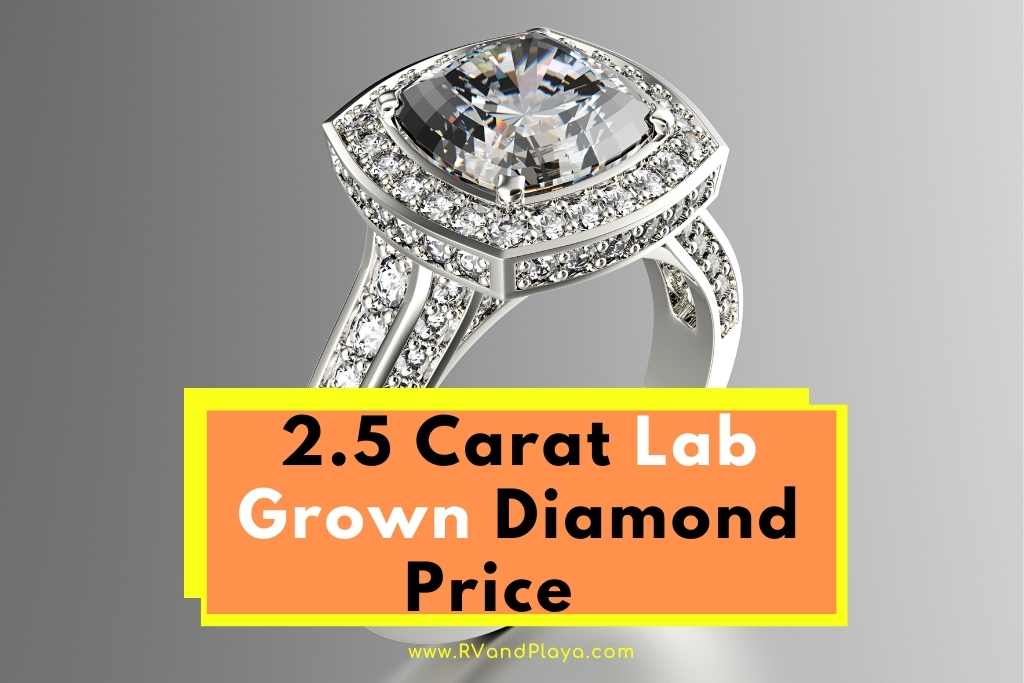Shopping for diamonds is a tricky business and trying to find something of significant size can become almost impossibly expensive.
If you want to find some more affordable options, then you will need to know the price of a 2.5 carat lab grown diamond.
A 2.5-carat lab-grown diamond will generally cost around $10,000-$20,000, which is significantly cheaper than the $20,000-$30,000 you would expect to pay for a natural stone.
Read on to find out much more about the cost of lab-grown stones, and what else affects how much they are actually worth.
Table of Contents
What Are Lab-Grown Diamonds?
Before we investigate exactly how much they might cost depending on their size, we should start to understand exactly what lab-grown diamonds actually are.
Lab-grown diamonds, also known as “lab-created diamonds” are a manmade version of those that are mined from the earth. They are made using one of a few special techniques and they can be produced much more efficiently and sustainably, with a significantly lower impact on the planet.
All of this means that these diamonds are not as expensive to purchase as a consumer, and they hold less value overall, but how exactly are they made?
Read also >> Are VVS Diamonds Lab Created? (Real Diamonds + More)
Read also >> Are James Allen’s Diamonds Lab Created? (Complete Guide)
How Much Cheaper Are Lab-Grown Diamonds?
Even though it would be very difficult for anybody to tell that a diamond was grown in a lab rather than found underground, they do come with a very different price tag.
Because the process of creating them is significantly less expensive than drilling or mining, the cost for the consumer can be much lower as well.
Typically, most lab-grown diamonds will be 50% – 80% cheaper to buy than those that were mined from the earth. This does also mean that they have less resale value as well.
All diamonds on the market should clearly indicate their origins (including the method by which they were created if they were grown in a lab), which is what gives them a lower resale value as well as a lower cost.
Read also >> How Much Is a 1 Carat Uncut Diamond Worth?
How Much Do Lab-Grown Diamonds Cost?
To get a really good picture of the price of these stones, let’s take a look at how much you can expect to pay for lab-grown diamonds by carat, compared to traditionally mined stones.
| Size | Lab-Grown Diamond Average Price | Mined Diamond Average Price |
|---|---|---|
| 0.5 Carat | $500 – $700 | $800 – $1,500 |
| 1.0 Carat | $1,500 – $3,000 | $3,000 – $6,000 |
| 1.5 Carat | $3,000 – $6,500 | $8,000 – $15,000 |
| 2.0 Carat | $5,000 – $12,000 | $12,000 – $20,000 |
| 2.5 Carat | $10,000 – $20,000 | $20,000 – $30,000 |
| 3.0 Carat | $20,000 – $30,000 | $25,000 – $50,000 |
These prices are general averages, and they can vary significantly due to many different factors – particularly the quality and characteristics of individual stones.
What Affects The Value Of Lab-Grown Diamonds?
When it comes to exactly how much a singly lab-grown diamond is worth, the carat weight is not the be-all and end-all of the equation.
Just like with mined diamonds, lab-grown diamonds are graded and assessed based on their features, and this will have a big impact on how much value they will hold.
The main features that are evaluated are known as the Four Cs: Carat, Clarity, Cut, and Color.
- Carat: The most simple (and often most impactful) feature of a diamond will be its carat weight.
- Color: When you’re looking at colorless diamonds, the level of perceptible hue will reduce the diamond’s value. This feature is graded from an almost completely colorless D all the way down to a faintly yellow Z.
- Clarity: Clarity refers to the number of inclusions (or minor faults) that are visible within the stone. A high-clarity diamond will have almost no dark spots, cracks, or cavities present.
- Cut: The quality of the shaping is known as the cut, and it will greatly affect how bright the diamond appears and how well it reflects light.
All of these factors and more are considered for each and every diamond that is sold, which is why their cost can vary so dramatically.
How Can You Determine The Quality Of A Lab-Grown Diamond?
To ensure that any diamond that you are looking to buy is the quality that you are expecting, lab-grown or not, you will need to make sure that you take a look at an official grading document.
All diamonds should come with a certification that proves their authenticity, states their origin, and details the features that are present on the stone. Typically, these assessments will be carried out by one of the major independent laboratories: the American Gemological Society (AGS), the Gemological Institute of America (GIA), or the International Gemological Institute (IGI).
There are a number of other bodies around the world that will also grade and assess diamonds, but these are the largest and most commonly used.
Experts at these labs will examine each individual stone and create a certificate that will tell you everything you need to know, and they perform the exact same service for lab-grown diamonds as well.
You should always make sure to look at one of these documents for any diamond so that you know you are getting what you pay for.
- Save an Average of $350* on Lab-Created Diamonds
- James Allen is the leader in online diamond sales
How Are Lab-Grown Diamonds Made?
There are two main methods that are used to create diamonds in a laboratory and they are known as HPHT and CVD.
Both of these methods start with what is known as a “diamond seed”, a tiny sliver of diamond that acts as the basis on which the rest of the stone will grow.
HPHT
HPHT stands for High Pressure, High Temperature. This method essentially replicates the extreme pressure and temperature that naturally causes diamonds to form beneath the surface of the earth.
The process follows a few steps:
- The diamond seed is placed into a press.
- The seed is heated to more than 1,000°C and put under pressure of more than 850,000 pounds per square inch.
- A carbon starting material, like iron or nickel, dissolves and the carbon migrates to the seed.
- Carbon crystallizes onto the seed in layers, growing the diamond.
- The crystal can then be shaped and polished.
CVD
CVD stands for Chemical Vapor Deposition. This process uses a gas mixture and slightly lower temperatures and pressures to create a diamond within a chamber.
The process works like this:
- The diamond seed is placed in a chamber.
- The chamber is filled with carbon-rich gasses.
- The chamber is heated to around 1,000°C.
- Microwaves are used to precipitate carbon from a plasma cloud onto the seed.
- As the layers form, the diamond needs to be removed and polished occasionally to remove any non-diamond carbon.
- Once finished, it can be shaped and polished.
Are Lab-Grown Diamonds The Same As Normal Diamonds?
One of the most important questions that people have, when they are shopping for lab-grown diamonds, is whether or not they are the same as the real thing.
The truth is, these diamonds are the genuine article, and their origin is practically all that separates them from any diamond mined from beneath the earth.
The chemical, physical, optical, and thermal properties of lab-created diamonds are completely identical to those of natural diamonds, and it is almost impossible to differentiate between the two.
Some highly skilled experts can look for clues that indicate whether or not a diamond was grown in a lab, such as color distribution, graining patterns, and phosphorescence – but the stones themselves are just as real as any other.
How Big Can Lab-Grown Diamonds Be?
For naturally-occurring diamonds, a large size is incredibly rare and very hard to cut and shape. That is part of the reason why lab-grown alternatives are becoming so popular.
With that being said, science has still not quite caught up to nature’s power when it comes to the truly massive stones.
A few natural diamonds have been unearthed that weigh hundreds, if not thousands, of carats. The largest of them is the colossal Cullinan Diamond, which weighed an incredible 3,106 carats before it was cut.
Lab-grown diamonds, on the other hand, cannot yet grow that big. With the methods as they currently are, HPHT diamonds can become as big as around 10 carats or more, while CVD diamonds can only reach a size of around 9 carats.
James Allen is the leader in online diamond sales. Their imaging technology is the same as inspecting a diamond with a jeweler's loupe. They have the largest exclusive loose diamond inventory online and fantastic prices.
They also have the nicest collection of lab created diamonds online. Save 10% off select lab grown diamonds and 25% off ring settings during limited time sale!
WHAT WE LOVE ABOUT THEM:
- No questions asked returns within 30 days of shipment. James Allen will send you a paid shipping label to return the ring.
- Lifetime Warranty
- Free International Shipping
- Free prong tightening, repolishing, rhodium plating and cleaning every 6 months
- Provide insurance appraisals
- One free resizing within 60 days of purchase
- Free ring inscriptions
- Best-in-class high quality imagery of all diamonds in stock
- 24/7 Customer Service
- Best-in-class packaging
Conclusion
So, what kind of price can you expect to pay for a 2.5-carat lab-grown diamond? Typically, a lab-created stone of this size will be worth between $10,000 and $20,000, whereas a natural 2.5-carat diamond would be more in the region of $20,000 – $30,000.
Lab-grown stones are much more sustainable and efficient to produce, which also makes them more affordable, and they are virtually indistinguishable from those that were formed over millions of years below the earth’s surface.
References
https://www.gia.edu/hpht-and-cvd-diamond-growth-processes
Recent Posts
When shopping for a diamond, you want to ensure you get the best product possible, whether natural or lab-created. James Allen offers a great variety of diamonds, but how are they made? James...
Most of us know there are naturally occurring diamonds and lab created diamonds. Both are beautiful. Both can be set to make exquisite jewelry. But naturally occurring diamonds are typically more...


